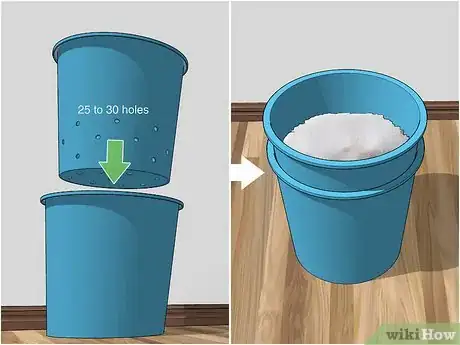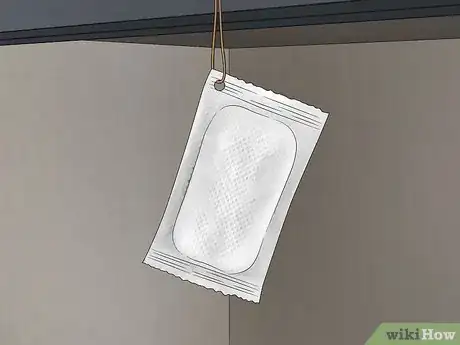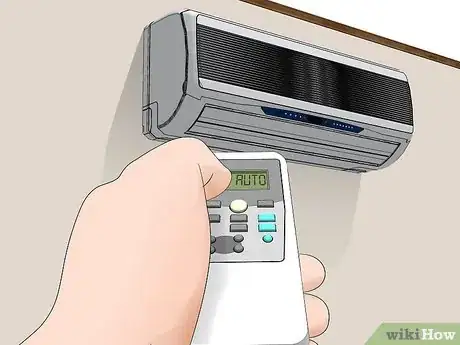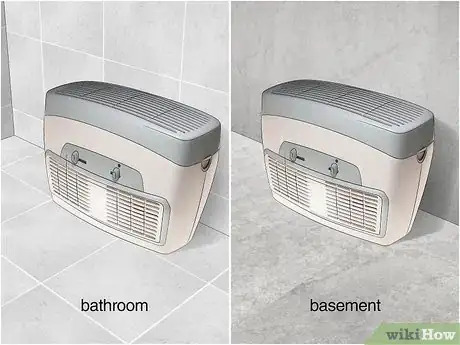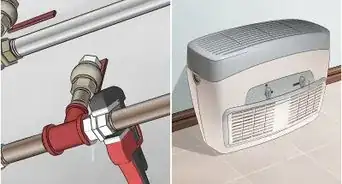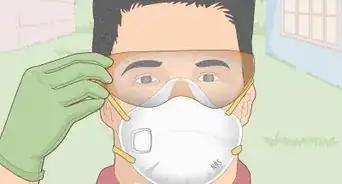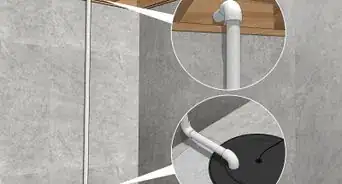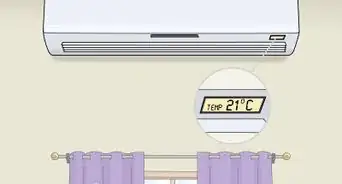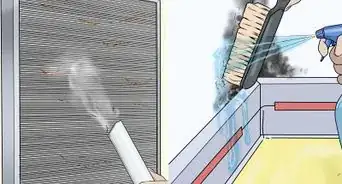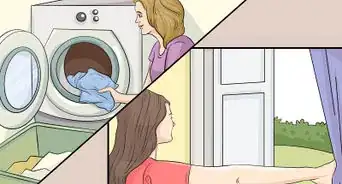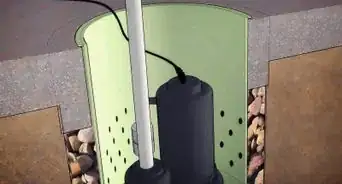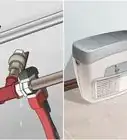This article was co-authored by Victor Belavus. Victor Belavus is an Air Conditioning Specialist and the Owner of 212 HVAC, an air condition repair and installation company based in Brooklyn, New York. In addition to HVAC and air conditioning units, Victor also specializes in furnace repair and air duct cleaning. He has over 10 years of experience working with HVAC systems.
There are 7 references cited in this article, which can be found at the bottom of the page.
wikiHow marks an article as reader-approved once it receives enough positive feedback. In this case, 100% of readers who voted found the article helpful, earning it our reader-approved status.
This article has been viewed 71,280 times.
Humidity in your home can make the air feel sticky, and it can even damage your walls and furniture if you're not careful. Dehumidifiers are the quickest way to dehumidify your home, but you can also ventilate your house. You can also make changes to your household to help draw moisture out of the air.
Steps
Making Household Changes
-
1Place baking soda around your home. Baking soda absorbs moisture, so it can help dehumidify your house. As a bonus, it's very cheap. Pour it into bowls, and cover them each with a thin cloth. Put them in various rooms around your house.
- Be sure to check on the baking soda every once in a while. As it cakes, you'll need to replace it.
-
2Try the rock salt and bucket method. Rock salt can pull moisture out of the air, but you need a place for that moisture to go, which is where the buckets come in. You'll need enough rock salt to fill a 5-gallon (19-liter) bucket, plus two 5-gallon (19-liter) buckets.[1]
- In one bucket, drill holes all along the sides and bottom of the bucket. You'll need 25 to 30 holes.
- Set the drilled bucket in the intact bucket; they will be stacked together, but you should have space at the bottom between the two for run-off. Pour in the rock salt. The salt will absorb moisture from the air, which will drip into the bottom bucket.
- Set the bucket in a room that needs to be dehumidified. You'll need to place one in each room to dehumidify a home.
- Check on the buckets at least once a week. You'll need to pour out the water that collects in the bottom bucket.
Advertisement -
3Try professional moisture absorbing products from hardware or home repair stores. You can also buy powders that are made to absorb moisture (they're usually made of calcium chloride). You can place them in containers around your home. You can also find these powders in large, breathable packets that you can hang around your house.[2]
- Look for products like DampRid or Humydry.
- To use these products in containers, place mesh netting in a plastic colander. Set it over another container, then leave the containers around your house. The water will drain into the bottom bowl, which you will need to empty out. You'll also need to change out the powders as they become saturated.
- You can find these powders at home improvement stores or online.
-
4Decrease water near the house. If water sits around your house, it can seep into your basement and foundation, increasing the humidity in your house. Make sure your gutters pipe the water away from your house. Also, it can help to build up your yard so it slopes down away from your house instead of towards it.[3]
- If you're not sure where to begin, consider calling a professional in to help you find ways to re-route water around your house.
- Another option is building a rain garden, which uses wetland plants to draw water away from the house.
Moving the Air Around
-
1Ventilate the room by opening a window. If the inside of your home is wetter than the outside, a simple solution is to open the windows. The drier air will draw the wetness out of your house. A fan in the window facing outward can help.[4]
-
2Use ventilation fans. In areas of high humidity in your home, you'll often have ventilation fans that run outside to help you dehumidify the area. For instance, both the kitchen and the bathrooms will likely have fans you can turn on and help dehumidify your home.[5]
-
3Turn the air conditioner on to "auto." If opening the windows isn't an option, switch on your air conditioner if you have it. One of the air conditioner's primary jobs is to dehumidify the air, so turning it on can make your home drier.[6]
- It's important to use the "auto" setting instead of just the "on" setting. The "on" setting leaves the air blowing all the time, even when the air is not cooling, which means the collected moisture doesn't have a chance to drain off. The "auto" setting switches off the fan when it's not cooling, so water can drain to the outside.
-
4Use space heaters or a fireplace to dry things out. If it's too cold for the air conditioner, dry heat (not gas) can also help to dry out your house. Try running a space heater, for instance. You can also use your fireplace to help dry out the air.[7]
-
5Avoid adding moisture to the air. Long, hot showers throw moisture into the air, making the situation worse. Similarly, an open boiling pot adds moisture, as well. In fact, even food cooked in a skillet can add moisture to the air. Try to keep your showers short, and turn the heat down as much as possible. Try covering your pots so the moisture stays mostly in the pot.[8]
- Also, remove some plants. If you have too many plants in your house, it can create a jungle-like atmosphere. They can produce a good deal of moisture, especially if you water them too much. Try sticking to just a couple of plants.
- You can also move them outside or keep them in a single room.[9]
Using Dehumidifiers
-
1Get enough dehumidifiers. While one dehumidifier will help, it likely won't be enough to dehumidify your whole home. You'll need to strategically place them throughout your house, especially in wetter areas, such as the basement and bathrooms.[10]
- You typically need to use a dehumidifier if you have moist stains on your walls or ceilings, your home feels stuffy, or you notice condensation building up on your windows.[11]
-
2Think about the noise level. Some dehumidifiers are quite loud, so you may need to purchase quieter ones for rooms you're in a lot. If you want a quieter dehumidifier, opt for peltier dehumidifiers instead of mechanical or refrigerant ones. "Peltier" refers to the technology used in the dehumidifier. While peltier dehumidifiers don't work quite as well as the other kinds, they are much, much quieter.[12]
-
3Decide what size is appropriate. Generally, larger dehumidifiers pull more water out of the area, so they're better for larger spaces. Smaller dehumidifiers don't pull as much water, but they'll fit better in areas like the bathroom or kitchen. Pick the size that's appropriate for the space.[13]
-
4Run your dehumidifiers. When you notice the moisture is increasing in your house, turn your dehumidifiers on. They'll pull the moisture from the air, reducing the humidity in your home.[14]
-
5Pour out the water. Because dehumidifiers collect the water from the air, the tank fills up with water. You need to pull the tank out and empty it in the sink at least twice a month. It's also a good idea to wipe out the inside with a damp cloth to remove any particle buildup.[15]
Expert Q&A
Did you know you can get expert answers for this article?
Unlock expert answers by supporting wikiHow
-
QuestionHow humid should my home be?
 Victor BelavusVictor Belavus is an Air Conditioning Specialist and the Owner of 212 HVAC, an air condition repair and installation company based in Brooklyn, New York. In addition to HVAC and air conditioning units, Victor also specializes in furnace repair and air duct cleaning. He has over 10 years of experience working with HVAC systems.
Victor BelavusVictor Belavus is an Air Conditioning Specialist and the Owner of 212 HVAC, an air condition repair and installation company based in Brooklyn, New York. In addition to HVAC and air conditioning units, Victor also specializes in furnace repair and air duct cleaning. He has over 10 years of experience working with HVAC systems.
Air Conditioning & Humidity Specialist
References
- ↑ https://dengarden.com/cleaning/Ways-to-Dehumidify-Your-Greenhouse-andor-Home-Environment
- ↑ https://dengarden.com/cleaning/Ways-to-Dehumidify-Your-Greenhouse-andor-Home-Environment
- ↑ http://www.criticalcactus.com/reduce-home-humidity/
- ↑ https://www.hunker.com/12002792/how-to-dehumidify-a-room-without-a-dehumidifier
- ↑ http://www.criticalcactus.com/reduce-home-humidity/
- ↑ https://www.hunker.com/12002792/how-to-dehumidify-a-room-without-a-dehumidifier
- ↑ https://www.hunker.com/12002792/how-to-dehumidify-a-room-without-a-dehumidifier
- ↑ http://www.criticalcactus.com/reduce-home-humidity/
- ↑ http://www.criticalcactus.com/reduce-home-humidity/
- ↑ http://www.criticalcactus.com/reduce-home-humidity/
- ↑ Victor Belavus. Air Conditioning Specialist. Expert Interview. 6 May 2020.
- ↑ http://www.criticalcactus.com/reduce-home-humidity/
- ↑ http://www.explainthatstuff.com/dehumidifier.html
- ↑ http://www.explainthatstuff.com/dehumidifier.html
- ↑ https://www.hunker.com/13409437/how-to-clean-a-dehumidifier

